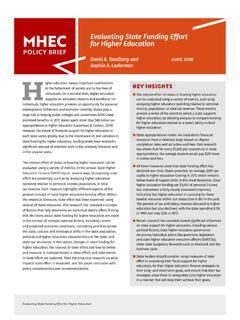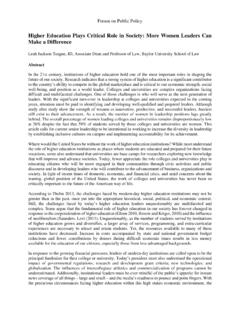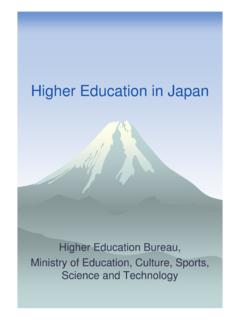Transcription of The Shaping of Higher Education: The Formative Years in ...
1 / 300f ja03 Mp 37 Friday Dec 17 09:03 AM LP JEP ja03 Journal of Economic Perspectives Volume 13, Number 1 Winter 1999 Pages 37 62 The Shaping of Higher education : TheFormative Years in the United States,1890 to 1940 Claudia Goldin and Lawrence F. KatzHigher education in the United States today has several salient character-istics: the large average size of its institutions; the coexistence of smallliberal arts colleges and large research universities; the substantial shareof enrollment in the public sector; a viable and long-lived private sector; profes-sional schools that are typically embedded within universities; and varying levels ofper capita funds provided by the states. Many of these features are often describedas having been an outgrowth of post-World War II developments, such as the , the rise of federal funding for Higher education , and the arrival of highereducation for the masses. This paper will argue, to the contrary, that the formativeperiod of America s Higher education industry, when its modern form took shape,was actually during the several decades after shifts in the Formative Years profoundly altered the Higher education in-dustry.
2 The decade around the turn of the 20th century witnessed the flourishingof the American research university and the emergence of public sector institutionsas leaders in educational quality. In the subsequent two to three decades, institu-jClaudia Goldin and Lawrence F. Katz are Professors of Economics, Harvard University,and Research Associates, National Bureau of Economic Research, both in Cambridge, Mas-sachusetts. During 1997-98, they were Visiting Scholars, Russell Sage Foundation, New YorkCity, New York. Their e-mail addresses are focus is on four-year Higher education . We omit two-year colleges, as well as independent teacher-training institutions, since most of the students at such colleges were there for only two Years . Beforethe 1940s, many professional schools (teaching law, medicine, veterinary medicine, pharmacy, and den-tistry) had programs for which the bachelor s degree was not a prerequisite nor was it granted at thetermination of the program.
3 Students in professional programs must, therefore, be grouped with all pre-bachelor s. See Goldin and Katz (1998) for a more detailed presentation of the statistical materials inthis of Economic Perspectives/ 300f ja03 Mp 38 Friday Dec 17 09:03 AM LP JEP ja03tions of Higher education vastly increased in scale, particularly those in the publicsector, and public sector institutions greatly expanded their enrollments relative totheir private counterparts. Universities widened their scope of operations by addinga multitude of highly specialized departments. Professional schools, which had beenmainly independent entities, became embedded in universities. Denominationalinstitutions, particularly schools of theology, went into absolute decline, and smallliberal arts colleges into relative decline. Something profoundly altered Higher ed-ucation around 1890 so that almost all of today s noteworthy universities andcolleges were founded before paper describes the shifts in industrial organization and political economyduring the Formative Years of Higher education from 1890 to 1940, some of thereasons for them, and a few of the consequences.
4 We begin with a discussion of the technological shocks that swept the knowledge industry in the late 19th andearly 20th centuries. These changes are crucial to understanding why the structureof the Higher education industry changed so abruptly from the 1890s to the 1920s,in terms of the increased scale of Higher education , its widened scope, the relativerise of public sector enrollments, and the commitment of particular states to highereducation. We next discuss enrollments and the founding dates of institutions,along with other descriptive data, to give a sense of the growth of the industry sfirms and clientele during the 1890 to 1940 period. We examine the political econ-omy of Higher education ; in particular, why the public sector grew relative to theprivate sector and what factors determined cross-state variation in funding highereducation from 1890 to 1940. In the conclusion, we turn to some of the conse-quences of publicly funded Higher education before World War IIBackground: Changes in the Structure, Creation, and Diffusion of KnowledgeThe business of colleges and universities is the creation and diffusion of knowl-edge.
5 The structure of knowledge by which we mean what was known and how itwas packaged into disciplines changed radically in the late 19th and early 20thcenturies. These changes, in turn, expanded the optimal scale and scope of insti-tutions of Higher education and gave an advantage to certain institutions, particu-larly those in the public the latter part of the 19th century, an increasing number of subjects taughtin colleges and universities became subdivided and specialized, and those whotaught began to define themselves as occupying separate, specialized fields. In eachsubject, these changes were brought about by somewhat different factors and atslightly different moments in time. Yet several factors are common to most. Theyinclude the application of science to industry, the growth of the scientific and ex-perimental methods, and an increased awareness of social problems brought aboutby an increasingly industrial and urban industry after industry, in the late 19th century, there emerged a growingimportance of chemistry and physics, most notably in the manufacture of steel,Claudia Goldin and Lawrence F.
6 Katz39/ 300f ja03 Mp 39 Friday Dec 17 09:03 AM LP JEP ja03rubber, chemicals, sugar, drugs, nonferrous metals, petroleum, and goods directlyinvolved in the use or production of electricity (Kevles, 1979). Firms that had notpreviously hired trained chemists and physicists did so at an increasing rate, as didthe federal and state governments. The number of chemists employed in the increased by more than six-fold between 1900 and 1940 and by more thanthree-fold as a share of the labor force; the number of engineers increased by morethan seven-fold over the same period (Kaplan and Casey, 1958, table 6). Sciencereplaced art in production; the professional replaced the tinkerer as greater demand for trained scientists, universities expanded their offer-ings. With new research findings, the classical scientific disciplines became increas-ingly fragmented, resulting in greater specialization. Greater specialization in bi-ology was driven by changes in empiricism and experimentation earlier stimulatedby the appearance of Darwin sOrigin of Species(Allen, 1979).
7 Analogous changesappeared in the agricultural sciences. But here part of the impetus was the ex-panding crop variety in the United States as the railroad spurred cultivation clearacross the continent, resulting in the growth of highly specialized farming (Rossiter,1979). Even the social sciences expanded and splintered in the late 19th and early20th centuries. They were given a mission by the growing social problems of in-dustry, cities, immigration, and prolonged depressions, first in the 1870s and laterin the 1890s. They were shaped by Darwinian thought, Mendelian genetics, andlater by the increased role of statistics, testing, and empiricism generally (Ross,1979).To illustrate the increasing specialization in academic disciplines we exploredthe numbers of learned societies founded over time, where, according to oneexpert, a learned society is (Kiger, 1963, p. 2):.. an organization composed of individuals devoted to a particular learneddiscipline or branch or group of disciplines in the humanities, social sciences,or natural sciences and primarily committed to the study and acquisition ofknowledge in such discipline.
8 [It] excludes professional societies in medicine,law, engineering, etc., where theraison d etreand primary emphasis is uponthe application of knowledge for professional and/or pecuniary purposes ..Our sample consists of all national learned societies existing in the United Statesin about 1980, when Kiger (1982) wrote his last volume on the subject, and thosethat are current members of the American Council of Learned societies came into existence in the 100 Years following the founding ofthe first the American Philosophical Society in 1743 and an additional six ap-peared before 1880. Then the pace picked up and 16 such societies came intoexistence from 1880 to 1899. Another 28 followed in the next 20 Years , from 19002 Very few national learned societies disappeared. An important one that did was the American SocialScience Association (founded 1865), which was less a learned society than it was an advocacy group.
9 Itgave rise to a host of professional organizations on crime and social service, as well as to the AmericanHistorical Association and the American Economic Association. Having thus exhausted its membership,it disbanded in 1912 (Kiger, 1963, p. 234 35).40 Journal of Economic Perspectives/ 300f ja03 Mp 40 Friday Dec 17 09:03 AM LP JEP ja03to 1919. Just 10 appeared from 1920 to 1939, although 20 were founded in the1940 to 1959 period. The final 20-year period in the data set 1960 to 1979 contains 12 more. The point is clear: the greatest period of founding of learnedsocieties was the first several decades of the 20th century during the time of disci-plinary proliferation in the expansion is evident in the social sciences. Economists formed their societyin 1885 and the rest quickly followed: psychologists in 1892, anthropologists in 1902,political scientists in 1903, and sociologists in 1905.
10 The biological and chemicalfields also proliferated in the 1890 to 1910 period, when societies were formed forbotanists, microbiologists, pathologists, electrochemists, and biological chemists, tomention a technological shocks in the structure of knowledge had far-reachingimplications for firms in the knowledge industry. Before this transition, duringthe early to mid-19th century, institutions of Higher education were often staffedby a mere handful of faculty, at least one of whom was proficient in ancient lan-guages and religion whereas the rest were sufficiently informed to teach philosophyand history. A member of the group would be the college s president, and he wouldhandpick the other faculty. But as a number of previous historians have argued,the Higher education sector in the United States changed fundamentally and tookon its modern features between about 1890 and 1910. For example, Hofstadter andHardy (1952, p.)













